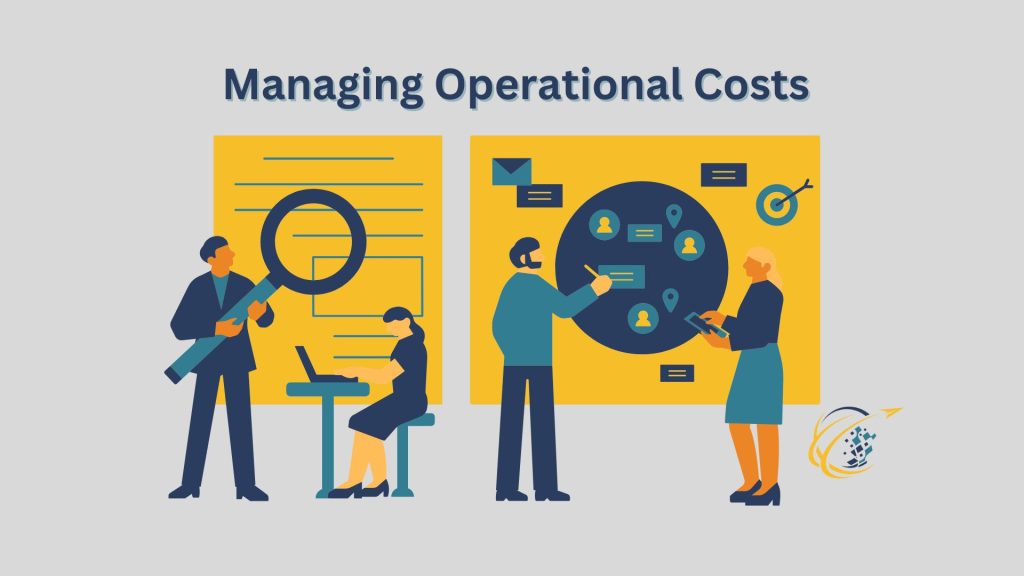 Managing operational costs is essential for building a sustainable, profitable business. Keeping expenses under control allows you to allocate resources more effectively and strengthen your bottom line. By implementing cost-saving strategies, you can improve efficiency and free up funds for growth opportunities. Below are practical methods for managing operational costs, from optimizing resource allocation and streamlining processes to leveraging technology and negotiating with suppliers. With these strategies, you can make informed decisions that enhance your business’s financial health and resilience.
Managing operational costs is essential for building a sustainable, profitable business. Keeping expenses under control allows you to allocate resources more effectively and strengthen your bottom line. By implementing cost-saving strategies, you can improve efficiency and free up funds for growth opportunities. Below are practical methods for managing operational costs, from optimizing resource allocation and streamlining processes to leveraging technology and negotiating with suppliers. With these strategies, you can make informed decisions that enhance your business’s financial health and resilience.
Cost-Efficient Resource Allocation
Efficient resource allocation is central to managing operational costs effectively. By optimizing how resources such as materials, labor, and technology are used, you can significantly reduce waste and lower expenses, making your business more competitive and sustainable.
One effective strategy is to implement lean management principles, which focus on minimizing waste within manufacturing systems while simultaneously maximizing productivity. For example, you might re-evaluate your production processes to identify areas where materials are used inefficiently or where too much time is spent on certain tasks. Streamlining these processes can reduce costs and increase output.
Another approach is to leverage technology to automate repetitive tasks. Automation not only speeds up production but also reduces the likelihood of errors and the waste associated with them. Investing in up-to-date technology might have a high initial cost, but the long-term savings can be substantial.
In terms of labor, consider cross-training employees. This makes your workforce more flexible and reduces downtime caused by staff absences or turnover. It also allows you to adjust more easily to changes in demand without the need to hire additional staff, thus better managing labor costs.
Additionally, regularly review your supplier contracts and seek to renegotiate terms when possible. Bulk buying or agreeing to longer-term contracts might secure lower prices for materials. However, it’s essential to balance the benefits of bulk purchasing against the risk of holding too much inventory, which can tie up capital and increase storage costs.
By focusing on these strategies, you can better manage your operational costs, ensuring that your business not only survives but thrives in today’s competitive market. Always remember, the goal is to achieve cost efficiency without compromising the quality of your products or services.
Energy Management
Effective energy management is essential for managing operational costs in any business. By reducing energy consumption, you not only lower expenses but also contribute to environmental sustainability. One of the simplest ways to save on energy is by investing in energy-efficient equipment. Upgrading to machines with high energy ratings can significantly cut down on electricity use, which translates directly into cost savings over time.
Additionally, implementing energy-saving practices can help minimize waste. For example, adjusting lighting and heating schedules to match operational hours can reduce unnecessary energy use. Installing motion sensors or automatic timers for lighting in low-traffic areas is also a practical way to conserve power. These small changes can lead to considerable reductions in your monthly energy bills.
Regular maintenance of equipment is another effective strategy. Machines that are clean and properly maintained tend to operate more efficiently, using less energy. This also reduces the likelihood of breakdowns, which can be costly and disruptive to your operations. Scheduling routine checks ensures that your equipment remains in optimal condition, lowering overall energy consumption.
Consider renewable energy sources as well, such as solar panels, to further reduce dependence on traditional power sources. While the initial installation cost may be high, renewable energy solutions can provide substantial long-term savings and tax benefits. As energy prices fluctuate, having a self-sustaining power source can help stabilize your expenses.
By adopting these energy management techniques, you can make a real impact on managing operational costs. Not only do these practices support your bottom line, but they also enhance your brand’s commitment to sustainability, which can appeal to environmentally conscious customers.
Supplier Negotiations
Effective supplier negotiations are a powerful tool for managing operational costs without compromising on quality or delivery timelines. The key is to approach negotiations with a clear understanding of your needs and budget. Begin by researching your suppliers’ offerings and comparing them with other options in the market. This knowledge provides a solid foundation for discussing pricing, delivery terms, and potential cost-saving opportunities.
When negotiating, focus on building a mutually beneficial relationship. Emphasize your commitment to a long-term partnership, as suppliers are more likely to offer favorable terms if they foresee a steady business relationship. You can also discuss volume discounts if you plan to place larger or more frequent orders, which often results in better rates.
Another effective tactic is to negotiate flexible payment terms. For example, requesting extended payment periods can ease cash flow and reduce short-term financial pressure. Alternatively, early payment discounts may be an option if you can pay ahead of schedule, benefiting both parties. Always ensure these terms align with your financial capabilities.
Lastly, communicate openly about your quality and delivery expectations. Set clear standards for the products and agree on timelines that work for both you and the supplier. This helps prevent misunderstandings and reduces the risk of delays, ensuring your business remains efficient and competitive.
By mastering supplier negotiations, you can effectively control your expenses and maintain high standards. This strategic approach allows you to meet operational demands while keeping a close eye on managing operational costs, making a positive impact on your business’s bottom line.
Technology and Automation
Investing in technology and automation can be a highly effective strategy for managing operational costs. By automating routine tasks, you can reduce labor expenses and free up your team to focus on more critical activities. Automated systems can handle everything from inventory tracking to customer service, increasing productivity and accuracy in these areas.
In addition to cutting labor costs, automation can significantly enhance efficiency. Automated systems work continuously without breaks, maintaining a steady workflow that speeds up production and minimizes downtime. For instance, using software to manage supply chains can help streamline ordering processes, reduce errors, and ensure materials arrive on time, ultimately saving costs associated with delays.
Technology upgrades often come with upfront costs, but the long-term savings can outweigh these initial expenses. For example, switching to energy-efficient machinery or cloud-based systems may reduce ongoing energy and maintenance costs. Many businesses also find that automated tools provide better data collection and analysis, enabling you to make smarter, data-driven decisions that improve overall performance.
Finally, technology and automation contribute to scalability. As your business grows, automated systems can handle increased workloads without needing significant adjustments or additional resources. This scalability allows you to expand operations smoothly, keeping costs manageable even as demand rises.
By incorporating technology and automation into your business model, you can achieve more sustainable growth and ensure greater efficiency. These innovations not only streamline processes but also play a crucial role in managing operational costs, giving your business a competitive edge in the long run.
Outsourcing vs. In-House Operations
Deciding between outsourcing and maintaining in-house operations is a key factor in managing operational costs. Each approach has its advantages and challenges, and the best choice depends on your specific business needs. Outsourcing certain functions, like accounting, IT support, or customer service, can save money by reducing labor costs and overhead expenses. By outsourcing, you avoid the need for extensive hiring, training, and benefits packages, which can add significant costs to your operations.
However, outsourcing is not always the right choice for every business. While it can reduce costs, it may lead to a loss of direct control over certain processes. This is especially critical for functions that require close monitoring or that impact your company’s core mission. Maintaining these operations in-house allows you to oversee quality and performance more closely, ensuring that they align with your company’s standards and values.
On the other hand, keeping functions in-house can be costly in terms of salaries, equipment, and infrastructure. For tasks that are not central to your business, these expenses may outweigh the benefits of in-house control. Outsourcing can also provide flexibility, allowing you to scale services up or down based on demand without the hassle of onboarding or layoffs.
Ultimately, your decision should be based on balancing quality, cost, and control. Assess which functions are essential to your business and require close oversight and which could benefit from the cost-efficiency of outsourcing. By making thoughtful choices about outsourcing vs. in-house operations, you can create a balanced approach to managing operational costs that suits your business model and long-term goals.
Regular Financial Audits
Conducting regular financial audits is essential for maintaining a clear picture of your business’s financial health. These audits help you identify inefficiencies and reveal areas where cost reductions can be implemented. By closely examining expenses and revenue, you gain insights that are key to managing operational costs more effectively.
A financial audit allows you to spot irregularities and unnecessary expenses that might otherwise go unnoticed. For example, you might discover redundant subscriptions, unoptimized vendor contracts, or overlooked billing errors. Addressing these issues can lead to immediate cost savings, freeing up resources for other business priorities. Regular audits also ensure that your financial records are accurate and align with your business goals.
In addition to identifying cost-saving opportunities, audits help you improve accountability within your organization. Reviewing financial processes and controls can highlight weaknesses in your system, allowing you to implement stronger, more efficient protocols. This can prevent future errors and help streamline operations, ultimately enhancing your company’s financial stability.
Moreover, conducting regular audits can also improve your decision-making. When you have a clear, up-to-date financial overview, you can make informed choices about budget allocations and investment strategies. This proactive approach to managing operational costs supports long-term growth and stability for your business.
Conclusion
In conclusion, managing operational costs is essential for maintaining a healthy and profitable business. By focusing on strategies like energy management, effective supplier negotiations, and regular financial audits, you can identify areas to reduce expenses without compromising quality. Investing in technology and evaluating outsourcing options also contribute to long-term savings by improving efficiency and productivity. Each approach offers unique benefits that, when combined, can create a robust cost management framework. Staying proactive and regularly reviewing your operations will help your business adapt to changing market conditions and remain competitive.


